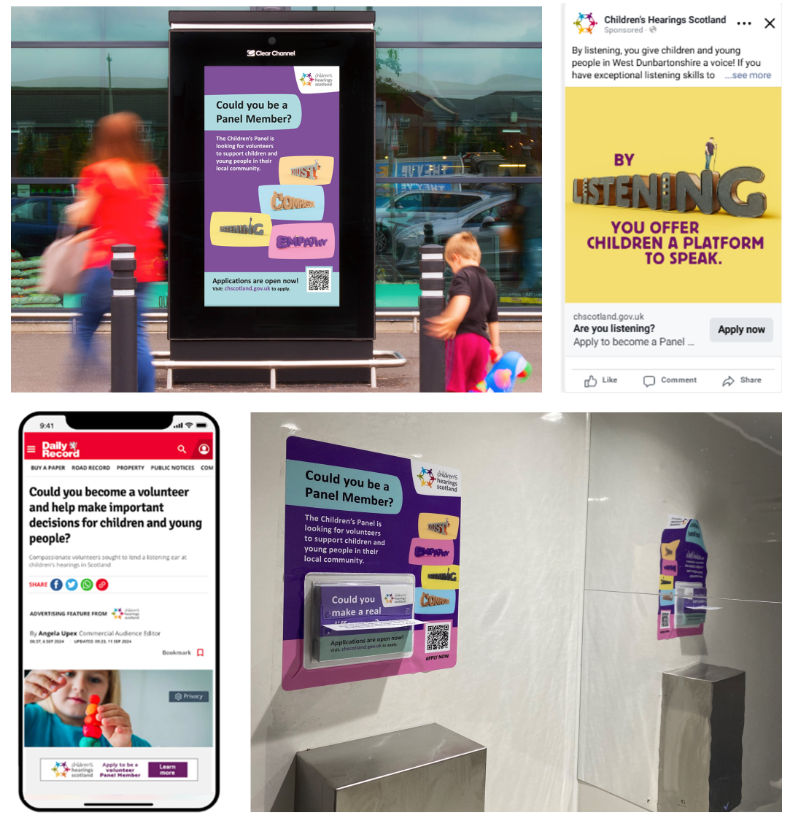What’s the future for news publishing?
Local and national news publishers play a crucial part of society – educating, informing and holding those in power to account. And for some advertisers with an older or regional customer base, newspapers remain a key medium. However, print circulations are in unstoppable decline, as the latest ABC figures for national press titles (below) demonstrate.

Of the newspapers which release audit data, only the Metro, Daily Mail and Mail on Sunday now have circulations over 200k. The Daily Mirror’s circulation is below 200,000 copies for the first time since the Edwardian era, a startling drop of 16.4% compared to February 2024. The biggest monthly drop was actually suffered by the Daily Mail, falling 5%, albeit still mustering a healthy 652,866 copies.
Regional titles are suffering much the same fate – sadly, no UK regional daily newspaper now has a print circulation of over 20,000 copies. Print circulations of regional daily titles declined 16.4% between 2023 and 2024, according to ABC data. Of course, publishers rightly point to their strong digital traffic as a sign that their content is still relevant to a large audience. For example, the The Herald (Scotland) now has a print circulation of only 9952, but can claim 2.1m monthly unique users online.
However, publishers are facing declining ad income and subscriptions at the same time as Google, Meta, and other digital platforms exploit their content by displaying headlines and articles to attract users and generate ad revenue – often without fair compensation to the original creators. Furthermore, the use of keyword blockers is limiting ads from appearing next to certain news publisher content – a practice most consumers disagree with, according to new research from Newsworks. It reveals that seven in 10 people agree advertisers should be investing more money in news brands and quality journalism instead of blocking it
Should advertisers and agencies be more proactive in supporting sustainable journalism, helping to curb the dominance of big tech in the digital economy? Let us know what you think on our social poll.
Commercial audio listening reaches 76% of UK adults every week.
The widespread adoption of connected audio devices is fuelling growth in the ad-funded commercial audio market, says a new report from Radiocentre. According to the Speed of Sound report, radio, podcasts and music streaming supported by advertising now reaches over three quarters (76%) of UK adults every week – growth of 5.3 million weekly listeners over the last 6 years. In addition, total commercial audio listening hours increased to 627.5m in Spring 2024, a 5% increase versus Spring 2023.
A small decrease in weekly commercial broadcast listening, down to 58% of UK adults, has been more than compensated for by an increase in connected audio, with 44% of UK adults now listening to the latter each week.

Podcast listening has doubled from 8% to 16.4% in the last 6 years, and now forms 11% of total commercial audio listening. Importantly, listeners to podcasts, and to radio streaming, are significantly younger and more affluent than radio audiences, as the chart below highlights.

These findings reinforce the need to combine the power of traditional radio with digital audio ads in podcasts and streaming, particularly for those brands with younger target customers. The tighter targeting and deeper emotional connection from digital audio enhances the mass reach delivered by traditional radio stations, improving outcomes for most campaigns.
Ofcom implements tighter controls on digital content.
As of 17 March 2025, Ofcom has begun enforcing the UK’s Online Safety Act, compelling digital platforms to take stronger measures against illegal and harmful content. Social media giants, video-sharing platforms, and search engines must now implement stricter moderation, transparency and user safety mechanisms or risk fines of up to £18 million or 10% of global revenue.
For UK advertisers, this enforcement brings significant improvements. Clearly, brands wish to ensure their ads do not appear alongside harmful or illegal content, as misplacement could damage reputations. Stricter enforcing around illegal and offensive content will reduce the possibilities of this happening. As always, The Media Shop will work closely with compliant platforms and utilise brand safety tools, such as Integral Ad Science, to minimise risks in this area.

YouTube: the new television?
You might say that YouTube has been the sleeping giant of the digital world over the last 20 years. Its has the second largest audience after Facebook, well ahead of TikTok and X, but with a much lower share of the limelight and controversy. In the year it marks its 20 birthday, YouTube CEO Neal Mohan has been laying out his vision for the future with 4 bold ‘bets’: that YouTube will remain at the epicentre of culture; YouTubers are becoming the startups of Hollywood; YouTube is the new television; and AI will supercharge content creation.
The third ‘bet’ – based on the fact that TV is now the primary device for YouTube viewing in the US – has stirred debate. Thinkbox was quick to point out this does not mean YouTube is the main thing watched on TV sets – in fact it only accounts for 11.1% of US TV viewing, and just 8.1% in the UK. They do concede this is higher for 16-34s at 16.2%. But you could say YouTube is still a sideshow on the big screen.

Still, UK broadcasters are leaning in. ITV has recently followed Channel 4 and joined YouTube’s partnership programme, with 100s of hours of their high quality programming now available on the platform. C4 says that, in their experience, this is not cannibalising audiences but delivering incremental – and younger – viewers. For advertisers, it’s an affordable opportunity to place brands next to premium, made-for-TV content – good news when recent research shows that YouTube content that meets BARB’s ‘fit for TV’ standard delivers 40% improved attention on ads compared to less premium videos.
BARB, the TV audience measurement body, has also announced it will start measuring YouTube viewing on TVs, with the first daily audience data including YouTube figures expected in the third quarter of this year. The data will be based on 200 channels that Barb is currently selecting, and will give us a fuller scope of modern TV viewing, particularly for younger audiences.
Developments like these mean that, whilst YouTube may have some way to go to become ‘the new TV’, its certainly stepping towards a more mature and quality offering.
The Media Shop embraces sustainable campaigns
At The Media Shop, sustainability is placed at the heart of our operations. We are committed to reducing our environmental impact, and that of our clients’ campaigns, and to driving positive change across the industry. Our approach balances people, planet, and profit, ensuring long-term business success while protecting the natural world.
One of our key initiatives is our onboarding questionnaire for media suppliers. A series of checks around their sustainability (and DEI and Fair Work) policies and practices, ensures we only work with suppliers whose values align with ours.
We can also measure carbon outputs for client campaigns, positioning ourselves as a front runner in sustainability within the media sector. Using the IPA’s Carbon Calculator to calculate carbon emissions from paid media activity allows us to incorporate sustainability into our planning and reporting. Being able to measure the varying impact of different media combinations is a crucial tool for creating the most sustainable campaigns. Ask your Account Director if you would like more information on this service.

Client Spotlight

Children’s Hearings Scotland plays a vital role in supporting children and young people by recruiting, training, and supporting volunteer Panel Members who make crucial legal decisions within Scotland’s children’s hearing system. Since being appointed in 2021 under the Scottish Government Media Buying Framework, The Media Shop has played a key role in shaping and executing impactful volunteer recruitment campaigns – delivering expert media planning, buying, insight, and digital support across seven recruitment campaigns.
One of the biggest challenges for Children’s Hearings Scotland is that volunteer requirements vary widely across different regions. To tackle this, recent campaigns have strategically focused on areas with greatest need – often remote locations like Argyll & Bute and the Western Isles, where media opportunities can be limited. Leveraging our extensive databank of local media opportunities, The Media Shop crafted a smart, cost-effective strategy that combined a broad-reaching campaign approach with tailored, location-specific media solutions.
Campaigns have included broadcast TV and radio activity, including a bespoke editorial package with Bauer Radio, featuring interviews with real Panel Members. Digital ads run across Meta and Google, with native content on Reach’s Scottish network. Micro-local targeting comes from hand-picked rail and roadside poster sites, community radio, and a range of print and digital formats with community publishers. We also used Tactical Media’s bespoke service to seek out and install washroom panels in cafes and bars in rural areas.
Over these 7 campaigns, almost 30,000 volunteer application starts can be attributed back to the paid media activity. Catherine Goodfellow, Children’s Hearings Scotland’s Recruitment and Retention Manager said, “The Media Shop has played a vital role in devising our paid media strategy over the last 4 years. Their experienced insight and advice has proved invaluable in creating campaigns that keep the Panel supplied with volunteers who perform such a vital role in society.”

Just the headlines
Netflix’s Adolescence is first streaming show to top BARB weekly ratings.
In a watershed moment for the TV industry, Adolescence’s first episode reached 6.45m viewers, with closest linear show The Apprentice reaching 5.8m. Read more…
Meta to stop targeting human rights campaigner with personalised ads.
Court case could prompt Meta to charge users for an ad-free version. Read more…
Channel 4’s launches emissions tool.
Channel 4’s new tool will give advertisers emissions data for campaigns on their owned and operated digital platforms, a first for a major broadcaster. Read more…
Amazon Prime to offer new shoppable ad formats in 2025.
UK users will be able to buy via pause ads, a shoppable carousel format and another interactive format, without being taken out of the Prime Video player. Read more…
Scotland has the edge in scenery, heritage & uniqueness, says tourism report.
Digital Director, Fiona Mills, learned about the challenges in the tourism sector at the Scottish Tourism Alliance Conference this month. The good news from the Scotland Outlook 2023 report is that the sector has transitioned from recovery to growth post-pandemic. Our country’s world leading attractions, natural beauty and of course, its people are what make it an attractive destination.
